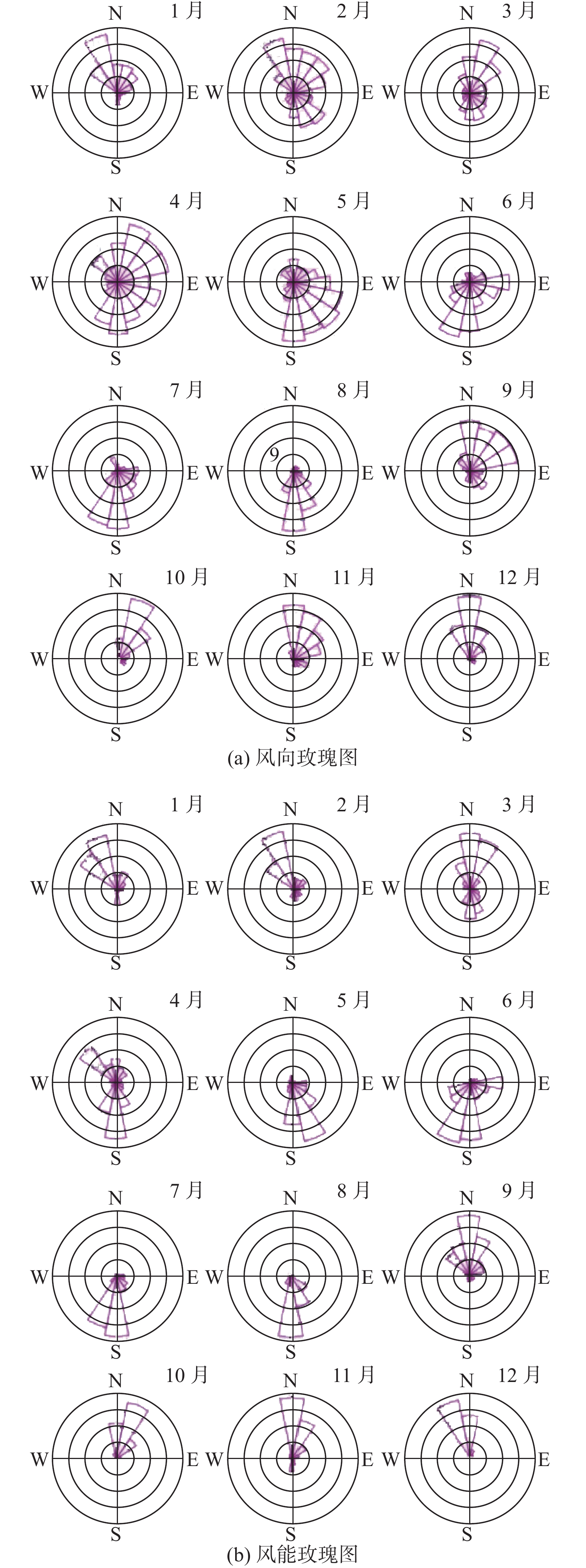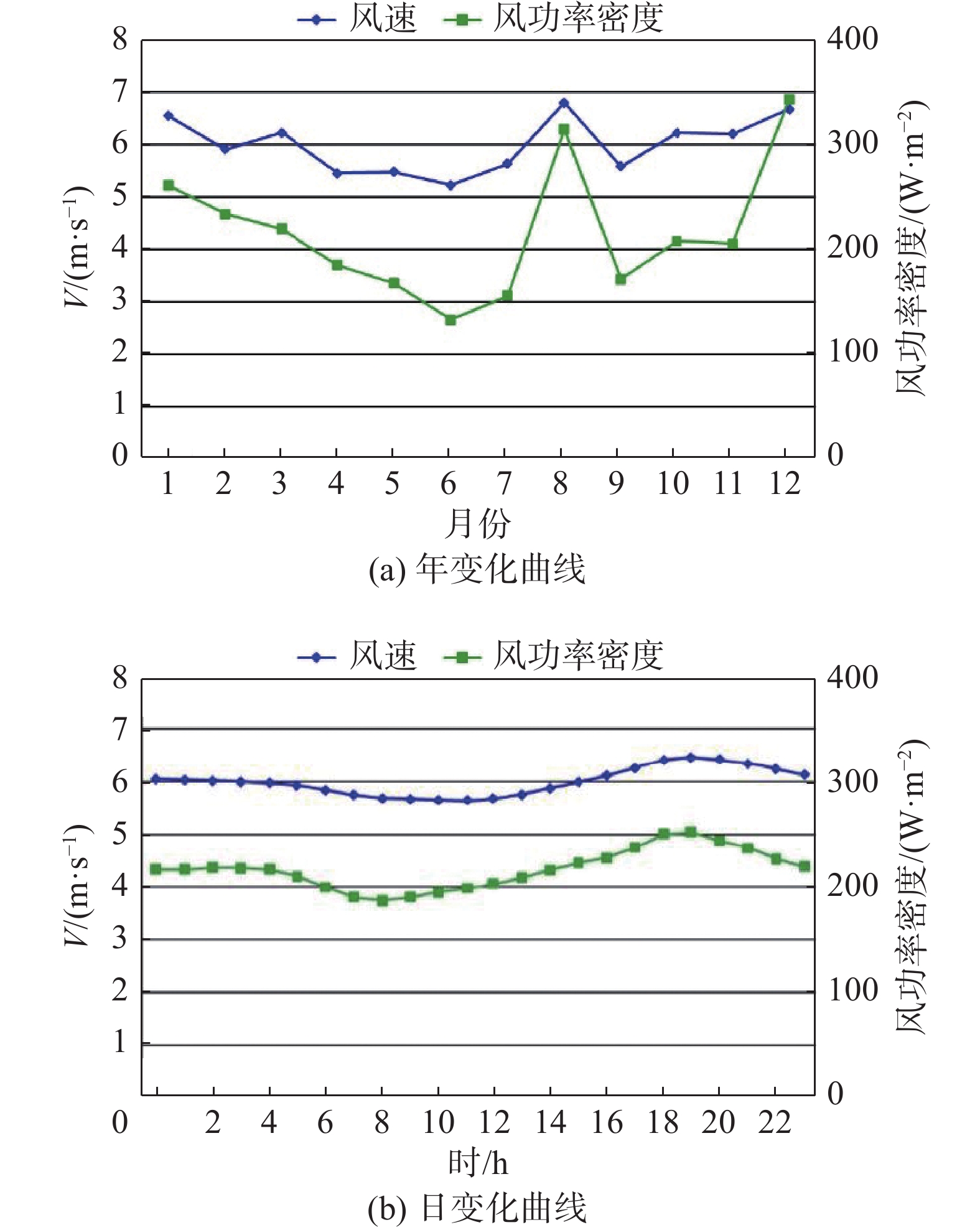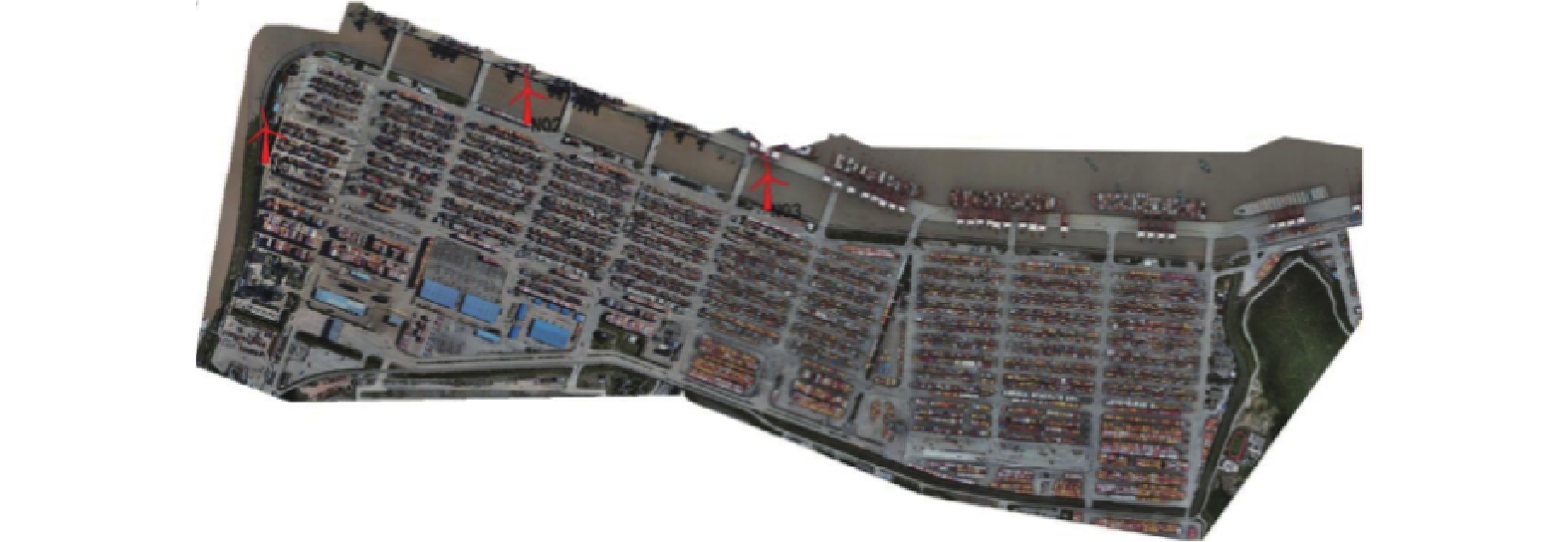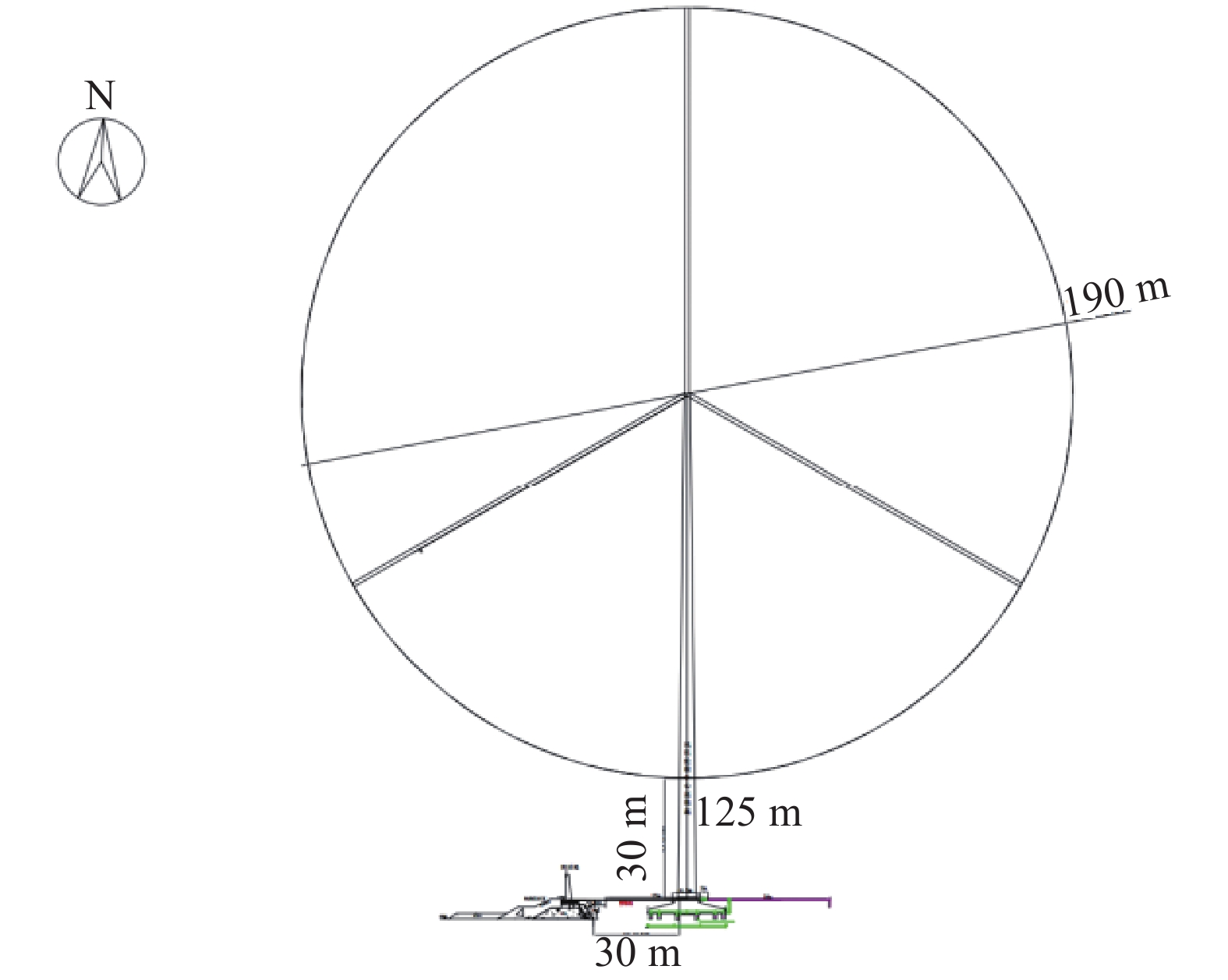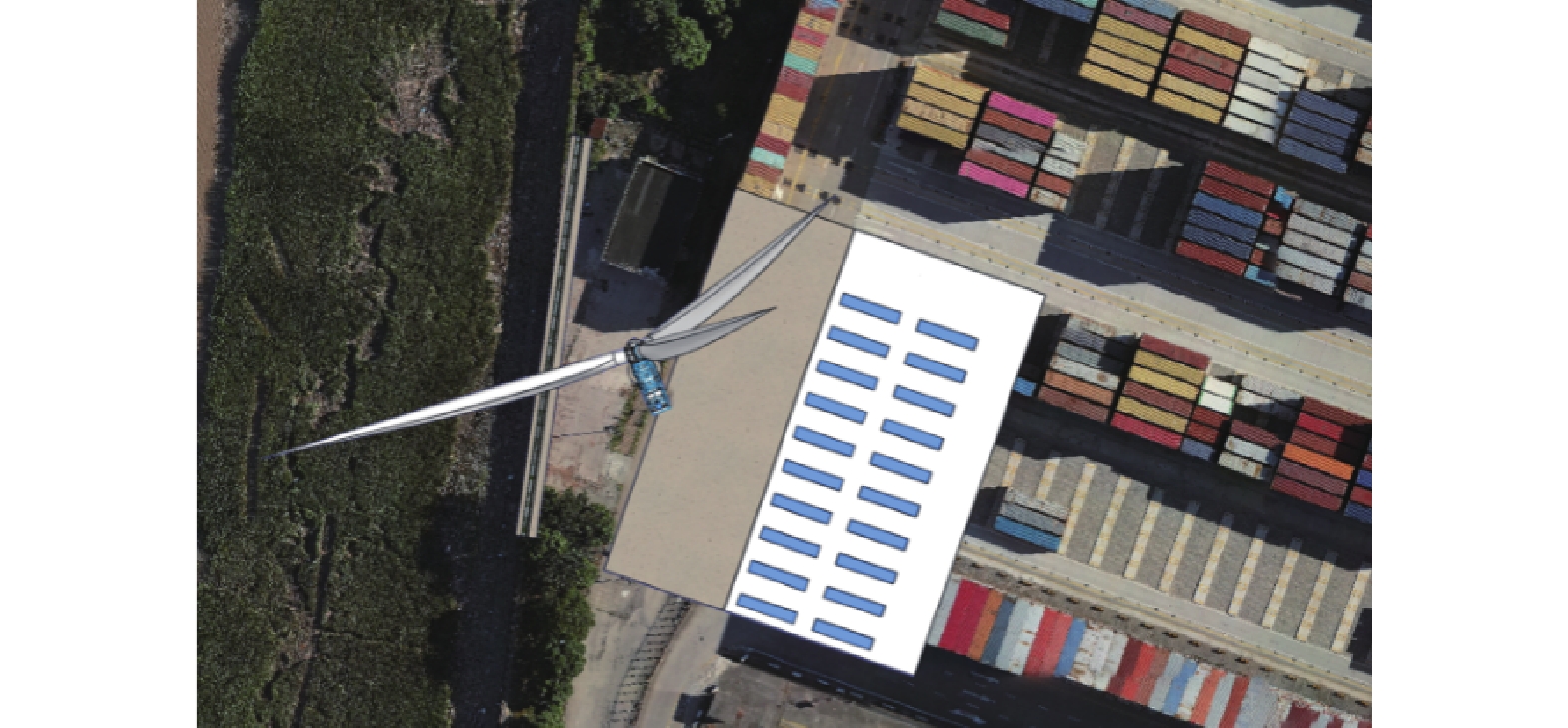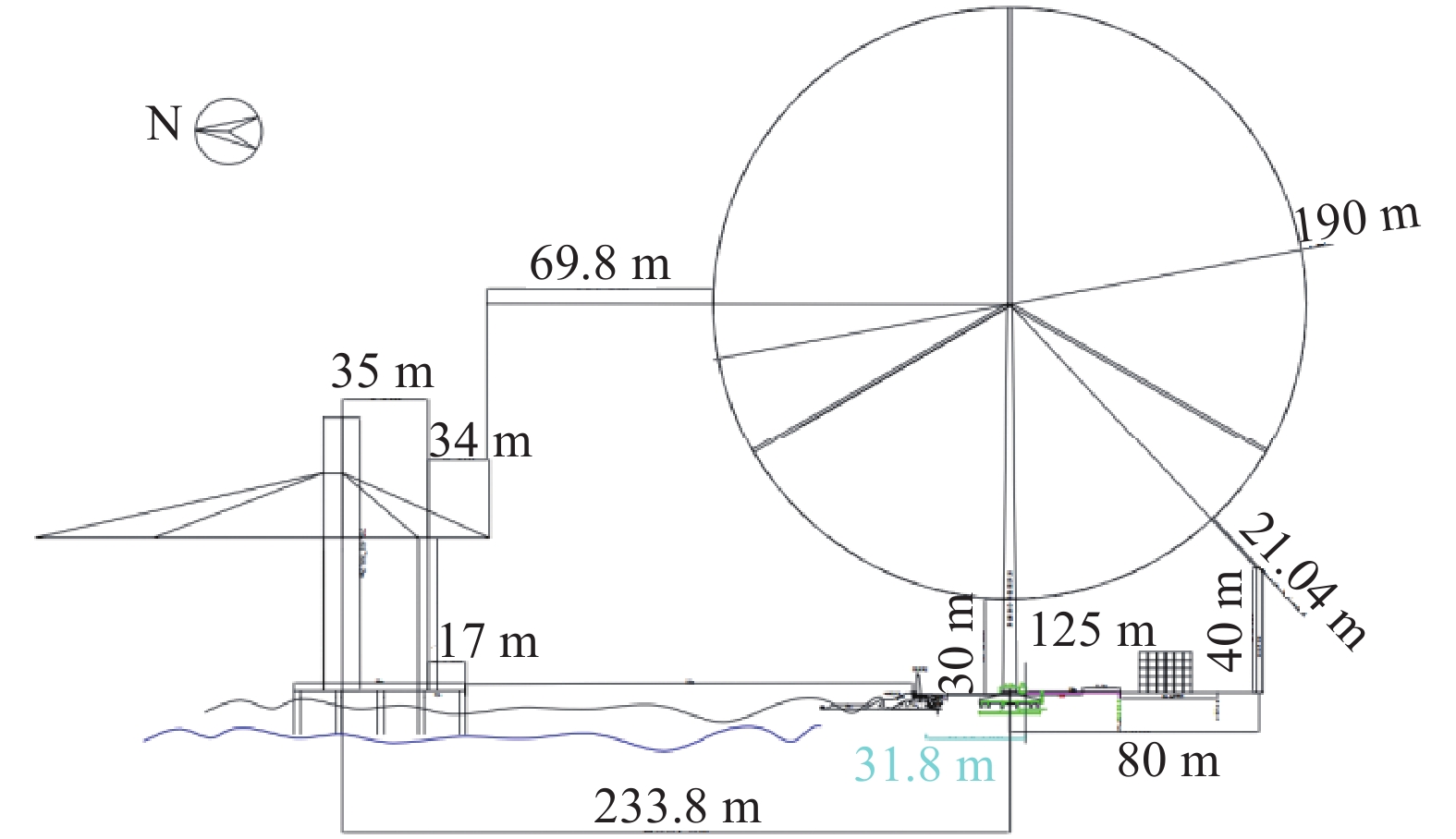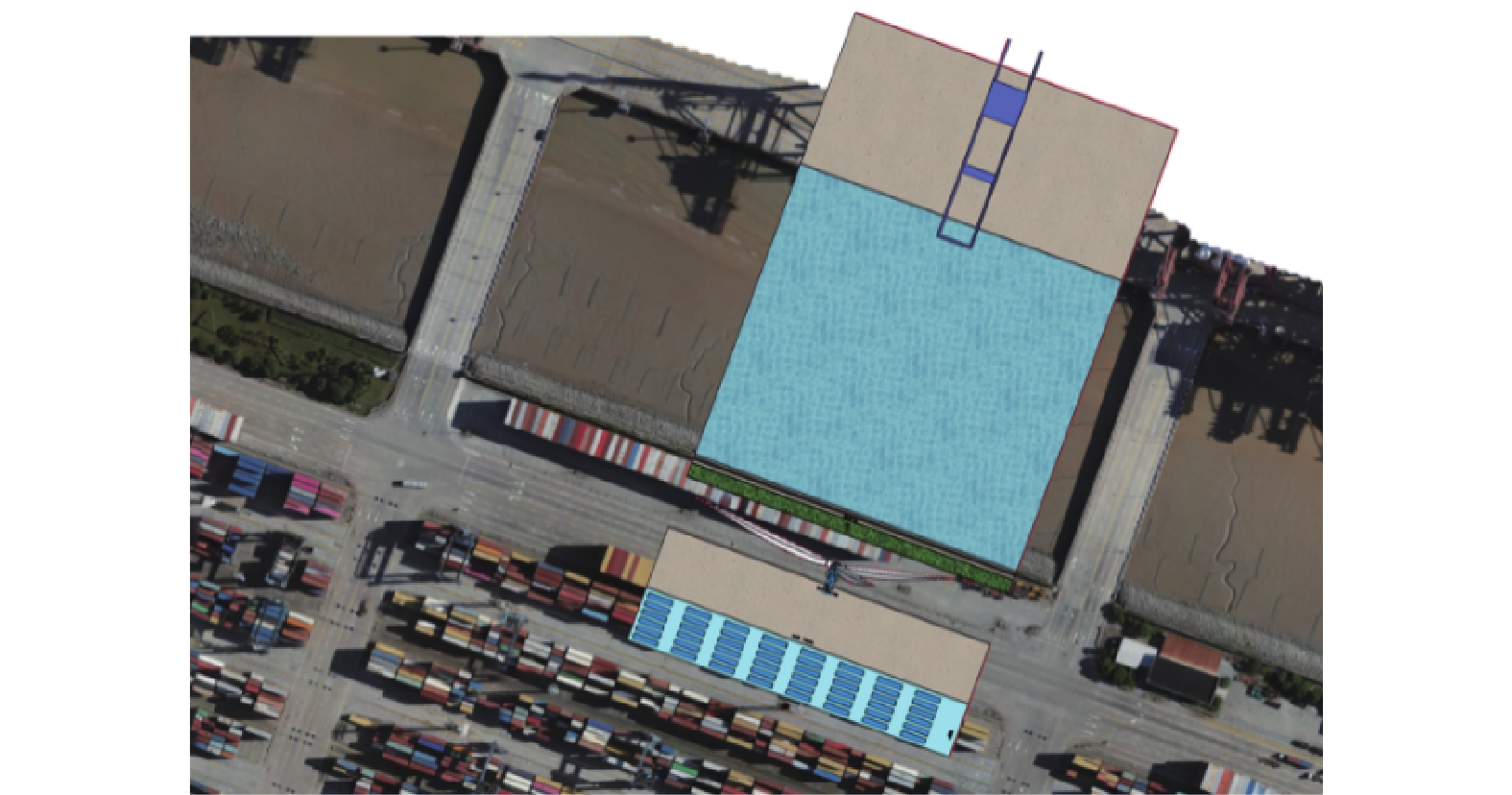-
近年来,与全球气候变化密切相关的极端天气、自然灾害频发,为应对气候变化,世界各国纷纷制定碳中性、碳中和气候目标,积极应对气候变化成为全球共同性议题[1]。中国也提出了CO2排放力争于2030年前达到峰值,努力争取2060年前实现碳中和的目标[2]。大力推动可再生能源发展是应对当前能源危机和环境问题的重要手段。
风力发电技术是一项经过充分验证且具有较大效益的技术,对于促进地区治理大气污染、转变经济发展方式具有重要意义[3-5]。截至2022年年底,全国风电累计装机超过18万台,容量突破390 GW[6],“十四五”期间,新能源仍将继续快速发展,装机和发电量占比仍将持续提高[7-8]。国家能源局指出未来几年我国的风电发展模式为:在大型风电地区促进风电规模化发展的基础上,支持风资源不太丰富的地区,发展低风速风电场,倡导分散式风电开发模式。风电场逐渐由传统地区向东南沿海地区发展,如福建、两广等低风速地区[9-12],而港口风电场是介于陆上和海上风电场的一个特例。柳成等[13]针对低风速区的风电场的建设,通过实测数据,采用柱状图以及气象玫瑰图对风电场场址风能资源进行综合评价,以确定场址、风机型号以及风机的布置。IEC 61400-1∶2019也规定了确保风力涡轮机结构完整性的基本设计要求[14]。Olabi等介绍了可用风力发电机组技术的一般选择指南,详细讨论了与风能转换系统相关的各种组件的前景及其局限性[15]。上述研究主要侧重于陆上或海上风电机组选址或选型,即通过分析有代表性的测风塔资料,系统分析不同地区的风资源特性[16-19],为风电机组选址及选型等提供重要参考。但大多数研究都致力于陆上或海上风电场选址和风电机组选型[20-22],没有针对港口这一特殊场景进行设计[23-24]。对于港口大型风电机组选址和选型而言,如何在不影响港口安全生产的前提下充分利用港区周边闲置地块,并使得所选风电机组型号满足高安全性、低噪声、高耐腐蚀性等要求,对港口分散式风电场开发、风电机组选址及选型提出了更大的挑战。本文以宁波舟山港穿山港区为例,分析了港口风力发电机组的限制性因素和设计原则,结合港区实景,对港口大型风力发电机组选址及选型进行工程化设计分析,为港口风电场设计提供参考。
-
穿山港区海拔高度0~3 m。港区区廓呈长方形,东西端最长3.75 km,南北端最宽1.5 km。港区内设立一座激光雷达,坐标为29°53′9.69″N,122°1′41.48″E,于2022年1月4日开始正式测风。本文根据MERRA-2再分析数据对港区的风能资源进行较长时间尺度上的分析,再分析港区一年的风能数据进行港区近期风能资源情况分析。
风电场的勘测设计工作主要包括场址地质勘查、风能资源评估、微观选址和财务评价等[25-26]。由于港口风电场的风能资源存在不均匀性,且港区内人类活动频繁,存在较多制约风电机组布置的因素,选择经济技术指标相对较优的风电机组以及布置位置就显得尤为重要。因此,本文重点对港口风电场的风能资源评估、风电机组选址及选型等进行分析。通过分析穿山港区风资源潜力以及港区基础设施能源化潜力的基础上,建立港区多能源融合系统仿真模型,评估穿山港区多能源融合系统的经济与排放特性。通过数字模拟和港区测得的数据进行风资源分析,明确港区的风发电潜力,并为后续风出力的计算以及多能源融合系统的评估、设计和运行管理等提供决策支持。
-
穿山港区沿岸陆域以低山丘陵为主,间隔分布小型海积平原,岸外有舟山群岛星罗棋布。区境属亚热带季风气候,温和湿润,四季分明。风向季节性变化强,夏季盛行东南风,冬季盛行西北风。通过对该区域的风能资源分析发现,场址区域内风速、风向差异较大。因此,准确掌握区域内风能资源分布情况,对风电场工程设计起着决定性作用[27]。
-
对于风能情况的分析,采用天气研究及预报(Weather Research and Forecasting,WRF)中尺度数值模式初步分析场区风资源水平,同时参考MERRA-2再分析数据,根据其他测风塔数据进行模型检验。MERRA-2长序列及测风年平均风速统计数据如表1所示。
MERRA-2 平均风速/(m·s−1) 与测风年差值/(m·s−1) 1983~2022(近40 a) 6.52 0.07 1993~2022(近30 a) 6.51 0.08 2003~2022(近20 a) 6.52 0.07 2013~2022(近10 a) 6.42 0.17 2022.01~2022.12(测风年) 6.59 - Table 1. MERRA-2 long sequence and annual average wind speed statistical datas
穿山港区代表年125 m高度风能和风向情况如图1所示。从图中可以看出,场区轮毂高度主要风向分别为NNE、N和S,相应频率分别为12.6%、11.7%和10.1%;轮毂高度主要风能方向分别为NNW、N和S,相应频率分别为16.3%、15.9%和14.9%。
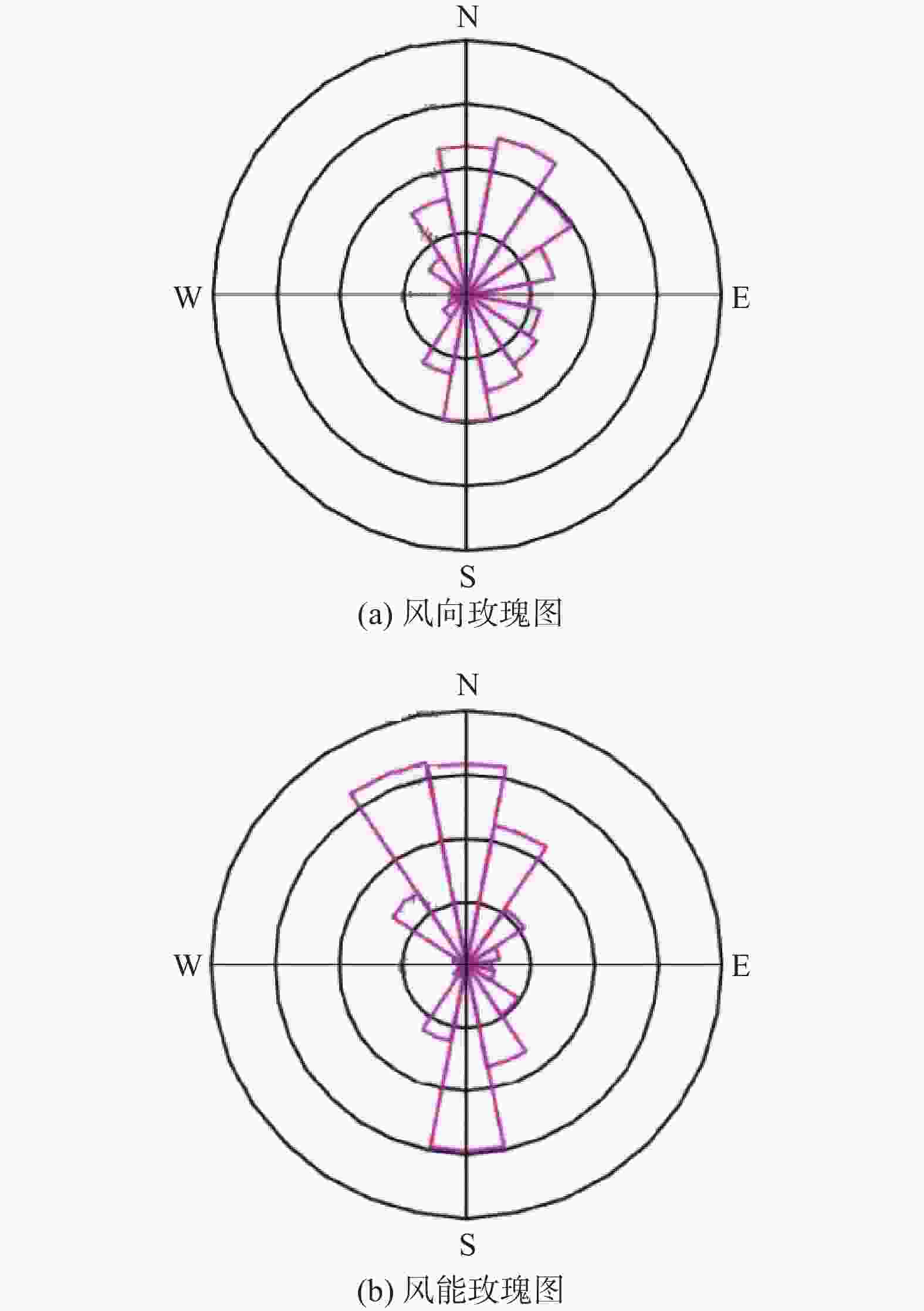
Figure 1. Rose diagram of wind direction and wind energy at 125 m height in representative year of port area
港区代表年125 m高度各月风向和风能玫瑰图如图2所示。从图中可以看出,港区的风向夏季和冬季较为单一,夏季主要风向为SSW、S,冬季主要风向为N、NNW;春秋季节风向较为杂乱。对于港区的风能,夏季主要集中在S、SSW;其他季节主要分布在NNW、N和NNE。
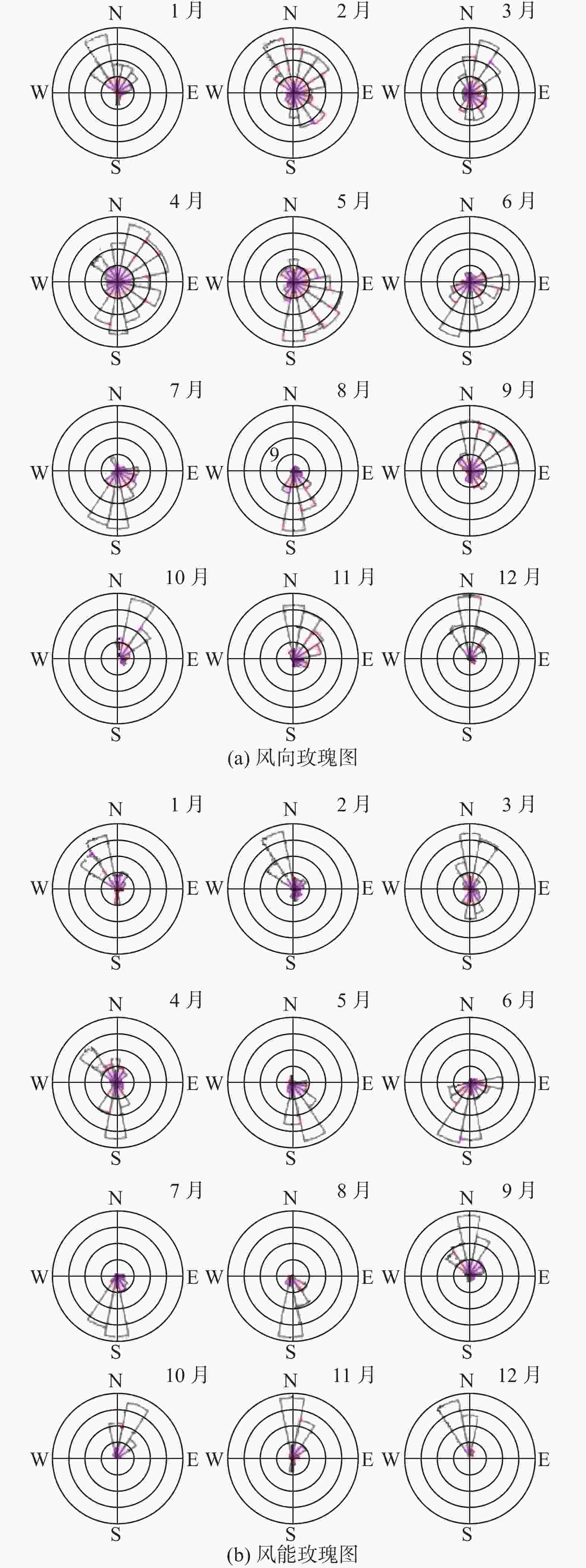
Figure 2. Monthly wind direction and wind energy rose diagram at a height of 125 m in a representative year of the port area
穿山港区代表年125 m高度风速和风功率年变化曲线、日变化曲线分别如图3(a)、图3(b)所示。从图中可以看出,港区的风速呈现出一定的季节性特点但是变化较为缓和,在冬季和夏季风速较大,最大月平均风速出现在8月,月平均风速为6.8 m/s,最小月平均风速出现在6月,月平均风速5.22 m/s。风功率呈现出较强的季节性特点,变化较大,最大月平均风功率密度出现在12月,月平均风功率密度为343 W/m2,最小风功率密度出现在6月,风功率密度为133 W/m2。从风速和风功率日变化曲线上看,港区风速和风功率日变化较为平稳。清晨8时至午后1时风速处于较低水平,下午至傍晚逐渐增加,晚间8时达到最高点,而后开始缓慢下降,在深夜至次日凌晨风速变化趋于平缓。风功率密度的日变化情况与风速基本一致。
-
穿山港区位于浙江东南海港区域,对风电场造成影响的特殊气候主要是热带气旋和大风等。其中,区域热带气旋以穿山港区中心为圆形,设置半径100 km为区域为本区域热带气旋统计区域。根据国家级气象观测站点数据,所有进入统计区域的热带气旋的路径显示,影响本次统计区域的热带气旋路径主要为转向类路径。1949~2021年期间,影响本次统计区域的热带气旋年均0.4个,每年热带气旋影响本次统计区域的时间在5~9月。
通过历史数据分析,港区65 m高度处50年一遇最大风速在52.1 m/s左右。根据IEC61400-1: 2019风力发电机组第1部分:设计要求(Wind energy generation systems——Part1: Design requirements)的设计标准[14],风力发电机组选型的基本参数如表2所示。结合表2以及风资源、特殊气候等分析,本风电场宜选用IEC I类及以上且具抗台特别设计的风电机组或满足抗台要求的S类风电机组。结合数值模型及港区周边项目实测成果初步判断,平均风速为15 m/s时,港区125 m高度湍流强度低于C类(0.12)。
风电机组等级 Ⅰ Ⅱ Ⅲ S ${{{V}}}_{{\rm{Tref}}}$/(m·s−1) 57 55 50 由设计者确定各参数 A${{{I}}}_{{\rm{ref}}}$ — 0.16 — B${{{I}}}_{{\rm{ref}}}$ — 0.14 — C${{{I}}}_{{\rm{ref}}}$ — 0.12 — 注:${{{V}}}_{{\rm{Tref}}}$:轮毂高度处50年一遇10 min平均极端风速;${{{I}}}_{{\rm{ref}}}$:平均风速为15 m/s时轮毂高度处湍流强度的特征值;定义同IEC61400-1:1999;A:表示较高湍流特性等级;B:表示中等湍流特性等级;C:表示较低湍流特性等级。 Table 2. Basic parameters of typhoon-resistant wind turbine grade
-
风电场微观选址是一个复杂的系统工程,涉及风能资源、地质、机组布置等,对于风电场建设、运行而言至关重要,也是风电场取得良好经济效益的关键[28]。而风电机组选址及选型过程、发电量估算等又是微观选址工作的中心内容及评判依据。文章将结合港区实际情况,着重分析风力发电机组选址过程及选型问题。
-
风电场通过每台风电机组把风能转化为电能,风经过风电机组转轮后速度下降并产生紊流,沿着下风向一定距离后,才能消除前1台风电机组对风速的影响。在布置风电机组时,应充分考虑风电机组之间相互的尾流影响,确定各风电机组的间距,把尾流影响控制在合理范围内,同时兼顾工程集电线路和道路的投资,使项目经济性达到最优。
在风力发电机组的工程化设计中,首先,应充分考虑场址内盛行风向、风速、地形地貌等条件,在同等风况条件下,选择地质及施工条件较好的场地;其次,既要尽量减小风电机组之间的尾流影响,又要充分利用场区内的土地资源,同时兼顾工程集电线路和道路的投资,并且要考虑风电场区内限制条件,避免风电机组布置与噪声控制[29-31]、港区土地利用规划等相冲突。风电机组布置需考虑机组安全性,将风电机组的尾流影响控制在合理范围内。
-
1)海塘:机位点在海塘管理范围内,对于海塘的影响,其安全性已通过了水利部门的审查。
2)场区办公楼:风电场区域内分布有办公楼等房屋。风电机组布置时,尽可能远离,满足安全距离和避免风电机组的噪声影响。
3)电力线路:为避免风电场施工及运行期间对电力线路的影响,布置时尽量避让。根据《风电场工程微观选址技术规范》(NB/T 10103-2018),距离35 kV以上等级架空输电线路不宜小于风电机组倒塔距离的1.0倍。
4)道路:白中线位于场区南侧,为避免风电场施工及运行期间对道路的影响,根据《风电场工程微观选址技术规范》(NB/T 10103-2018),风电机组的塔筒中心与国道及高速公路、省道的避让距离宜分别大于1.5倍倒塔距离、1.0倍倒塔距离。
5)其他:港区内可能还存在其他限制性因素。
经过综合分析,穿山港区共有3个风力发电机组安装机位,如图4所示。
-
机位选址需充分考虑对于港口运营活动的影响,港口通常是繁忙的运输和贸易中心,机组选址时需要考虑港口的运营活动,特别是港区岸桥、龙门吊作业的影响以及堆场的正常运营,需要确保风电机组的选址不会对港口运营造成干扰或安全风险。
机位选址还需提前考虑风机接入电网的方案,港口通常有完善的基础设施和电网接入,需要考虑到电网容量、传输线路、变电站等因素,以确保风电机组能够有效地并入电网。由于N01、N02和N03号机位靠近港区已有的变电站,符合经济性的要求。
所有机位平均风速、入流角、风切变、湍流强度满足机组安全性要求,且所有机位和周边建筑均满足安全距离要求。N01号机位相对位置示意图及其三维示意图如图5、图6所示,N02和N03号机位相对位置示意图及其三维示意图如图7、图8所示。
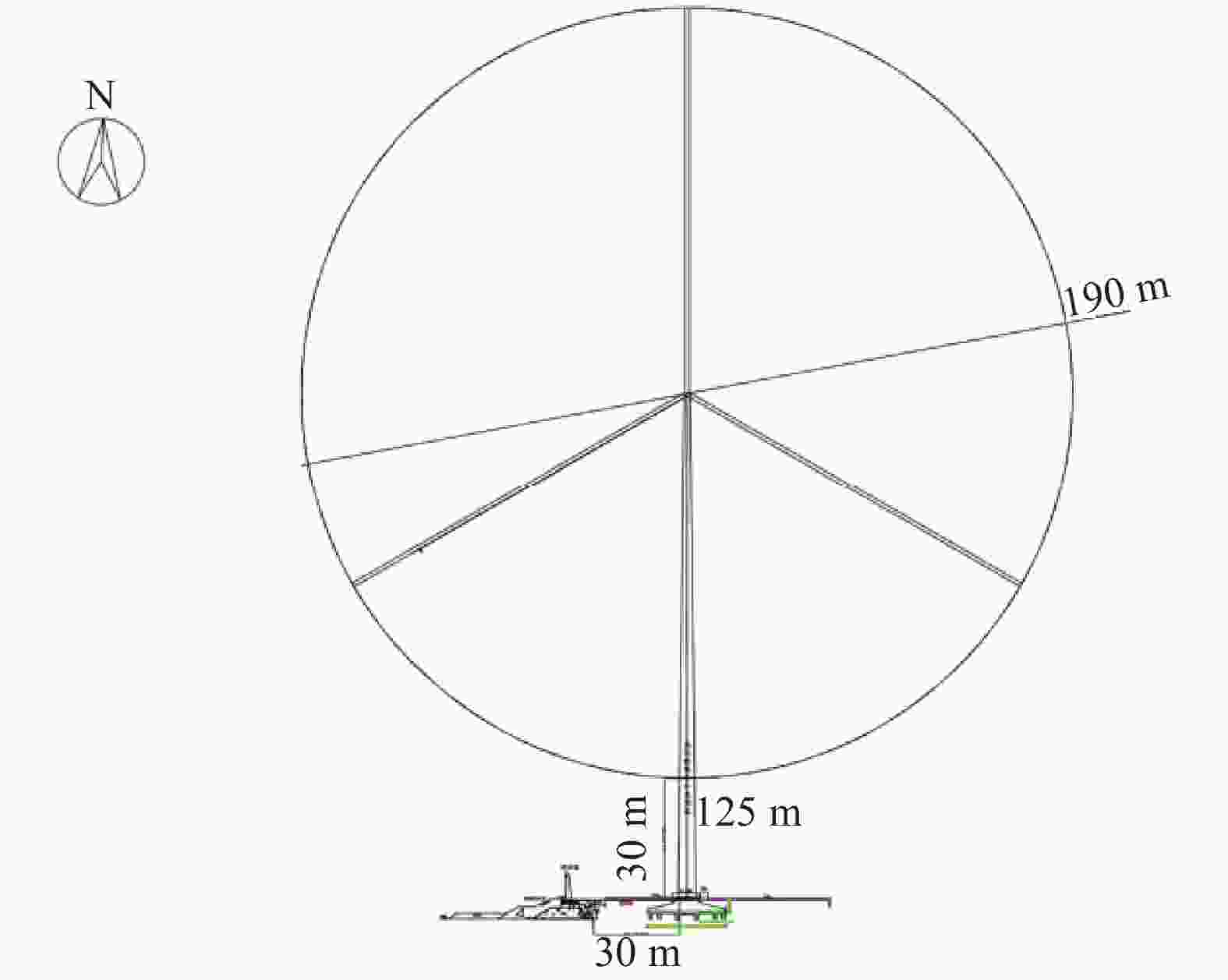
Figure 5. Schematic diagram of the relative position of N01 positions (190 m impeller/125 m hub height model)
-
目前,陆上风电机组单机容量在4.0~6.5 MW之间不等,总体来说,目前陆上风电机组呈现出以4.00 MW以上机组为主流,机组单机容量逐渐大型化的趋势。在选择风电机组时,根据电网公司对风电场接入电网的技术要求、各机型的技术成熟性、风电场风资源和安装运输等条件进行综合比较[32]。根据目前风电机组产业状况,选择单机容量在4.50~6.25 MW之间且满足IEC I类及以上具抗台特别设计的4种主流风电机组进行比选。结合机型的配套轮毂高度及周边限制性因素,按轮毂高度125 m进行分析。4种比选机型的技术特性如表3所示。
指标 WTG1 WTG2 WTG3 WTG4 额定功率/MW 4.50 6.25 5.50 6.25 装机台数/台 3 2 2 2 功率调节 变桨变速 变桨变速 变桨变速 变桨变速 转轮直径/m 156 190 190 172 风轮扫风面积/m2 19 113 28 353 28 353 23 235 单位千瓦扫风面积/
[m2·(kW)−1]4.25 4.54 4.54 3.72 切入风速/(m·s−1) 2.5 2.5 2.5 2.5 额定风速/(m·s−1) 9.5 9.5 10 10.5 切出风速/(m·s−1) 20~25 20~25 20~25 25 IEC等级 S S S S 极端(生存)风速
(3 s极大值)/(m·s−1)70 73.5 70 70 极端(生存)风速
(10 min最大值)/(m·s−1)50 52.5 50 50 运行温度/℃ −30~45 −30~45 −30~40 −30~40 生存温度/℃ −40~50 −40~50 −40~50 −40~50 Table 3. Table of technical characteristics of wind turbines with different model schemes
从表3中可以看出,WTG1~WTG4 4种比选机型的IEC等级均为S,满足本项目抗台要求的S类风电机组要求。本文进一步从发电量、工程投资和经济指标等方面对以上4种方案进行比较,如表4所示。
评价维度 指标 WTG1 WTG2 WTG3 WTG4 发电量 年理论发电量/GWh 33.88 32.15 23.10 26.15 年设计发电量/GWh 33.71 31.91 22.96 25.99 综合折减系数 0.76 0.76 0.76 0.76 年上网电量/GWh 25.62 24.53 17.44 19.75 工程投资 工程静态总投资/亿元 1.220 7 1.065 3 0.845 2 1.037 4 单位千瓦静态投资/
[万元·(kW)−1]9 042 8 522 6 302 8 299 经济指标 项目投资财务内部
收益率(所得税前)/%17.29 19.19 13.21 14.68 资本金财务内部
收益率(所得税后)/%15.38 17.15 11.43 12.97 Table 4. Technical and economical comparison of schemes of various models
从发电量上看,WTG1~WTG4 4种机型方案年上网电量分别为25.62 GWh、24.53 GWh、17.44 GWh和19.75 GWh;WTG1年上网电量最高,WTG2机型方案次之。从工程投资上看,WTG1~WTG4 4种比选机型方案的单位千瓦静态投资(不含送出)分别为9 042元/kW、8 522元/kW、6 302元/kW和8 299元/kW,WTG3机型方案的单位千瓦静态投资最低,WTG4机型方案次之。从经济性上看,WTG1~WTG4 4种比选机型方案的项目投资财务内部收益率(所得税前)分别为17.29%、19.19%、13.21%和14.68%,资本金财务内部收益率(所得税后)分别为15.38%、17.15%、11.43%和12.97%。综合来看,WTG2机型方案经济性最优,WTG1机型方案次之。通过以上分析,采用WTG2型每年上网电量可达24.53 GWh,每年可减少CO2排放约1.425 1 万t,节约用电成本0.233 亿元,实现较大的经济和生态效益。
-
1)分析了穿山港区风资源潜力,场区125 m高度主要风向分别为NNE、N,主要风能方向分别为NNW、N;港区风向和风能呈现出季节变化规律和日间不同时刻的变化规律,最大月平均风功率密度出现在12月,为343 W/m2,最小风功率密度出现在6月,风功率密度为133 W/m2;港区风速和风功率在清晨8时至午后1时风速处于较低水平,下午至傍晚逐渐增加,晚间8时达到最高点。
2)对港口风力发电机组的选址进行了分析,综合考虑海塘、港区办公楼、电力线路和道路以及港区现有堆场布置等限制因素,选择了3个适宜建设风力发电机组的位置。
3)对港口风力发电机组的选型进行了分析,选择市场上满足要求的4种主流机型进行分析,从技术特性、发电量、工程建设成本以及经济性等因素进行了分析,最终选择WTG2机型。
4)对风力发电机组的效益进行了分析,采用WTG2机型风力发电机组,每年上网电量可达24.53 GWh,可减少CO2排放1.425 1 万t,节约用电成本0.233 亿元,实现较大的经济和生态效益。
Engineering Design Analysis of Large-Scale Wind Turbine in a Port
doi: 10.16516/j.ceec.2024.1.07
- Received Date: 2023-06-13
- Rev Recd Date: 2023-07-06
- Available Online: 2024-01-18
- Publish Date: 2024-01-10
-
Key words:
- green ports /
- wind energy /
- wind energy resource assessment /
- wind turbine selection /
- wind turbine site selection
Abstract:
| Citation: | TANG Daogui, KE Yao, ZHANG Qianneng, et al. Engineering design analysis of large-scale wind turbine in a port [J]. Southern energy construction, 2024, 11(1): 64-72 doi: 10.16516/j.ceec.2024.1.07 |




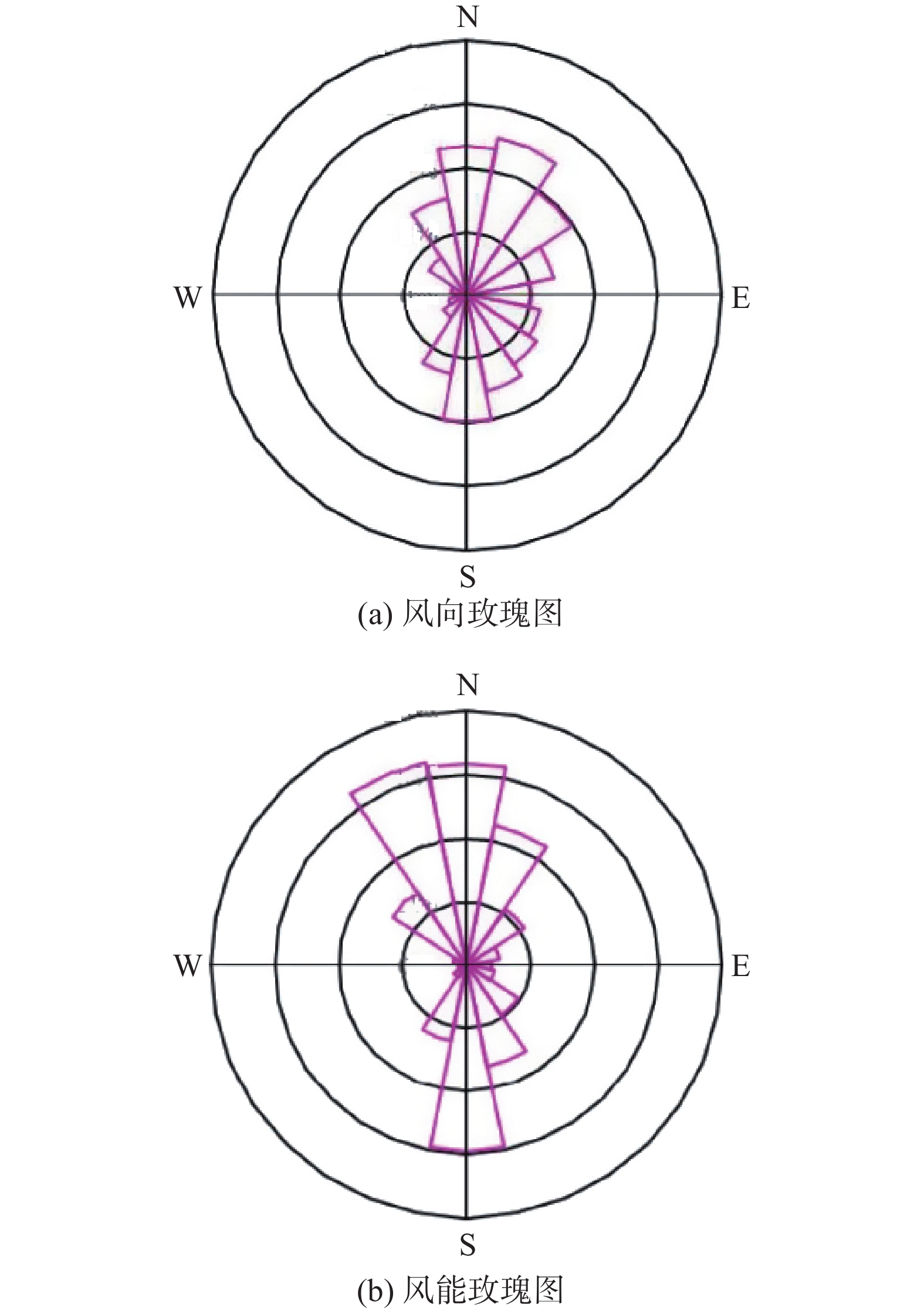

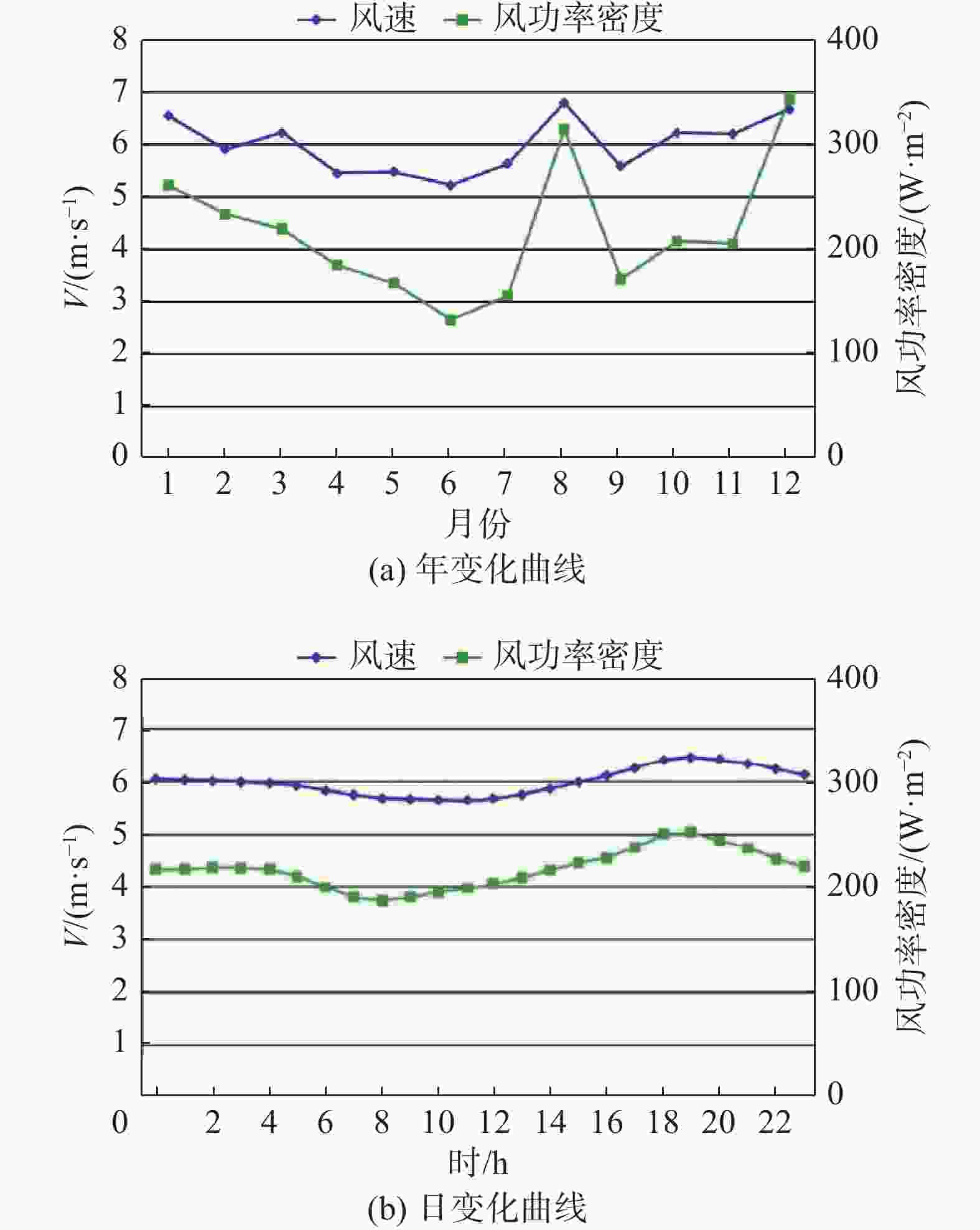
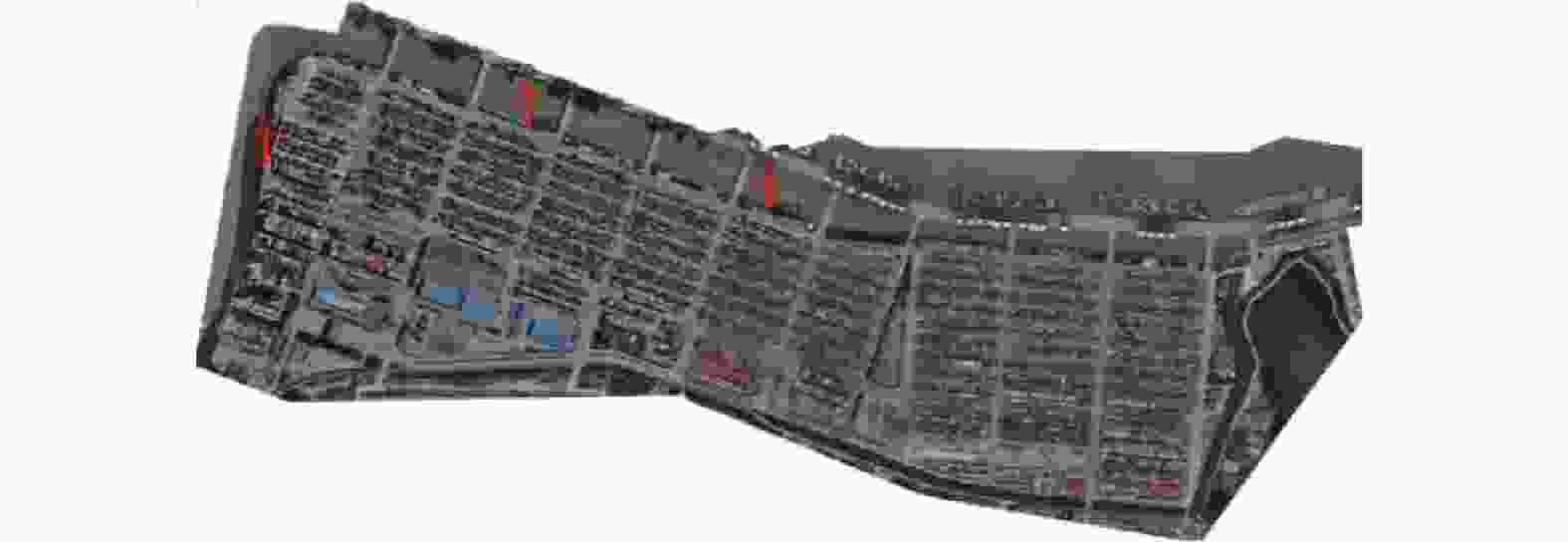

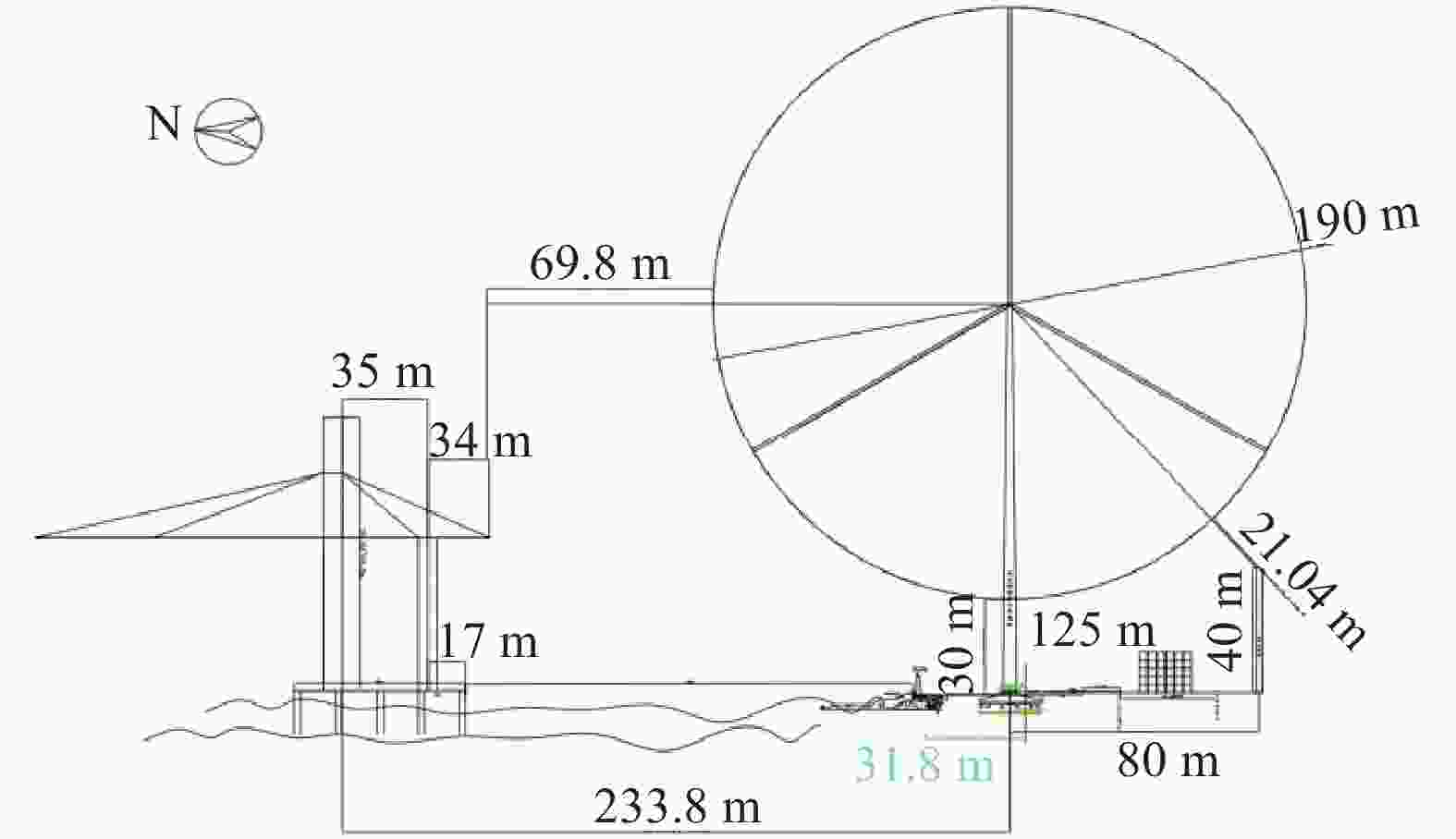


 DownLoad:
DownLoad:
